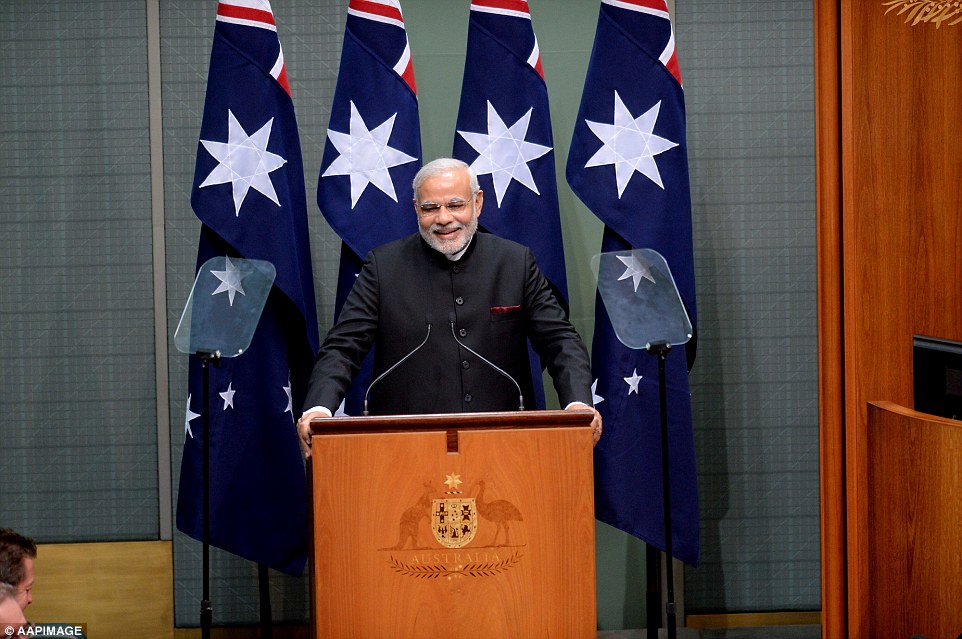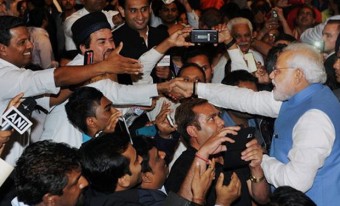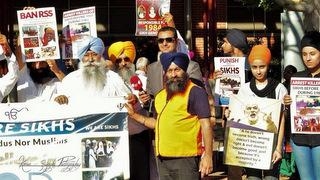
Why go to China when you can ‘Make in India’? This was the subtext of the speech given by the Indian Prime Minister Narendra Modi to a joint sitting of the Australian Parliament on Nov 18, 2014, as he attempted to publicise his new program designed to attract investment to India.
Australia has always been charged with India, as I wrote in Part One of this article. By geographical position and cultural connections with Asia that predate White colonization, Australia has also always been in an Asian century.
Yet White Australia has periodically felt threatened by Asia’s advancing, if imaginary, hordes. Many in that joint sitting smiled subtextually as Modi disarmed the Parliament with praise, called Prime Minister Tony Abbott his friend, and presented the youth of India as a market ripe for the taking.
A PM’s reception, like a riot, cannot happen by itself. It must be organized through hard work, and carrots. We all heard of the ‘rockstar’ reception at Sydney’s Allphones Arena even before it happened.
With all the hype surrounding the Indian PM, you could be forgiven for believing that the entire Indian diaspora in Australia adored Modi, who is from the Hindu far right Bharatiya Janata Party (BJP).

However, paying big money to see a rockstar is quite different from going to ‘see’ Modi for free. A crowd of 16,000 out of a diaspora of 450,000 is quite a small minority, especially if you consider that over 10,000 tickets were distributed for free in order to build up the crowds for this event.
It was packaged for the consumption of expatriate upper class Hindus, who through migration have moved from a majority in India to a minority in Australia, yet yearning, as Modi said, for the day when India would be like Australia.
The reality is that while all Indian Australians are equal, some are more equal than others. The organization of the “community” reception for the Indian PM was handed over specifically to a new group formed for the event, composed mainly of the Hindu Council of Australia and the Overseas Friends of the BJP, both Hindu sectarian organizations. The handling of the event has been criticized for the lack of consultation with other community groups.
Not everyone was fawning at Allphones Arena as the skies turned grey. About 200 people, including women, men, and children of the Sikh Australian community, as well as other individuals, appalled by the fanboy coverage of a person they consider a mass murderer and a liar, stood in peaceful protest outside the stadium where Modi spoke.

Gurpreet Singh Badwal, one of the organisers of the peaceful protest, said, “The Indian PM is an active member of the RSS (Rashtriya Swayamsevak Sangh), an extremist group, who only wants to see one Hindu nation. In India today there is no space for minorities such as Muslims, Christians, Sikhs, Dalits, Tamils, Kashmiris.”
The RSS is centered around the idea of Hindutva. The BJP’s official website states that Hindutva is a nationalist concept, which, according to the chief of the RSS, is linked to Hindu identity and the Hindu path for all of India, where, according to some, religious minorities such as Christians, Muslims, and Sikhs are second class citizens at best.
Modi’s electoral win earlier this year is often cited in the western media as an example of triumphant democracy. However, political commentator and columnist Irfan Ahmed analyses the BJP election victory not as a triumph but as a subversion of democracy, for reasons such as the systematic manufacturing of anti-Muslim polarization, the imposition of cultural assimilation into the Hindu fold, and the perversion of everyday language.
What is the distance between a rockstar and a hardline Hindutva place?
Contrary to public perception, Modi has not yet been given a ‘clean chit’ in relation to his role in the well documented attacks on Muslims in Gujarat in February 2002. Until recently Modi remained banned from entering the United States because of his role in the violence.
And it’s not just in Gujarat, the Sangh Parivar , the ‘family’ of Hindu Nationalist organisations of which Modi’s BJP is a part, have been responsible for the carnage enacted upon Christians, Dalits and Adivasis (tribal communities) and the burning of their homes, churches and other places of worship in Orissa in 2007-08.
Even as recently as October 2014, there have been ongoing communal riots in India, including in Gujarat, where five people have already been killed. Many have documented how the BJP, after winning the elections on the platform of economic development, are now back to hardline Hindutva.
Recently a criminal case has been filed against Modi in Australia by a survivor of the 2002 massacres in Gujarat, Asif Vohra under the aegis of the American Justice Centre. It charges Modi with crimes against humanity and genocide resulting in the killing of more than 2,000 Muslims, the displacement of several hundred thousand, the destruction of “20,000 Muslim homes and businesses and 360 places of worship.”
These are important interventions into the spawning of fawning over Modi, yet they have been drowned out largely by the big businesses that control much of the mainstream media in India.
India has more gods than Australia has people. Hinduism alone, as Professor Vinay Lal tells us, has approximately 330 million gods and goddesses, multiple centres of priestly authority, no single authoritative text, and no historical founder.
The transformation of an open, absorptive Hinduism, from these ancient, pluralist roots into the singular, hardline Hindutva agenda of the BJP and it’s parent organization, the RSS, can be seen in the comments of the RSS chief who talks of Hindutva swallowing all other identities in India.
However, nationalism is not patriotism, the BJP is not India, and historically ‘India’ is not Hindu. India is a country of old migrants, which explains its religious, and ethnic diversity.
The presence of hardline Hindutva in Australia, came into focus at the Vishva Hindu Parishad (VHP) conference in Sydney in 2008 where Swami Vigyanand gave, what cultural theorist and sociologist Goldie Osuri called, “a virulent hate speech directed primarily at Muslims”.
The VHP presents itself as a depoliticized organization loyal to Australia while simultaneously being loyal to the Hindu homeland.
It is sponsored by the Australian taxpayer through the federal Department of Immigration and Citizenship, the NSW Community Relations Commission, the NSW Federation of Community Language Schools, the Victorian Multicultural Commission, and various City Councils such as the City of Monash, Holroyd, Liverpool City Council, Hornsby Shire Council, and The Hills Council.
The RSS too has a presence in Australia, through the Hindu Swayamsevak Sangh (HSS) which, according to its official website, is ideologically inspired by the RSS in the homeland.
According to numerous commentators such as Osuri, Christoffe Jaffrelot, the South Asian Citizen’s Web, and Harvard University, speaking in relation to the global VHP organization, the flow of funds from its educational and charitable activities through Hindutva’s transnational networks are used to rewrite textbooks, and fund campaigns against Christians, Muslims in India.
No hard evidence is available for such economic flows in the Australian context. While state funding of community initiatives must be welcomed, systems must be put into place to ensure that taxpayer support for multicultural practices of Australia’s minority communities is not feeding oppressive Hindutva practices on India’s minority communities.
A lion caught in mid-prowl is the logo for Modi’s Make in India campaign. It is meant to symbolize manufacturing strength and national pride, as Modi attempts to present India as a viable and democratic alternative to China, whose cities are shrouded in a cancerous manufacturing-induced-dusk.
Yet, a lion is a predator, a destroyer rather than a creator, who sometimes, when the market is right, may just, subtextually, swallow the sun at dawn.
—————-
Part 1: Modi in Oz: Tweets, Diaspora and a PM of Science? can be found here.
Part 3: Modi in Oz: G20 and development coming soon.


1 thought on “Modi in Oz: Rockstar and Hindutva (Part two)”
Comments are closed.